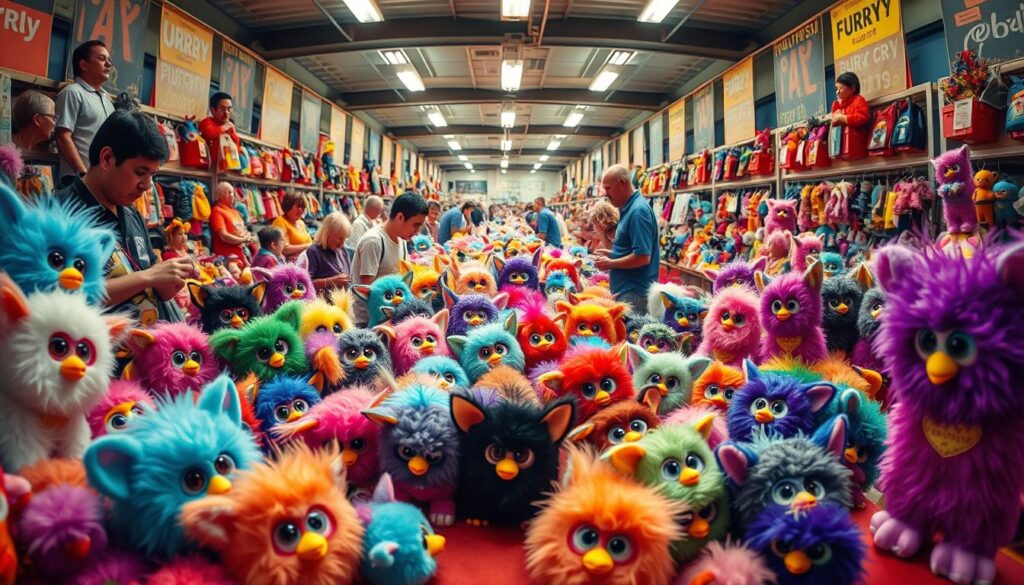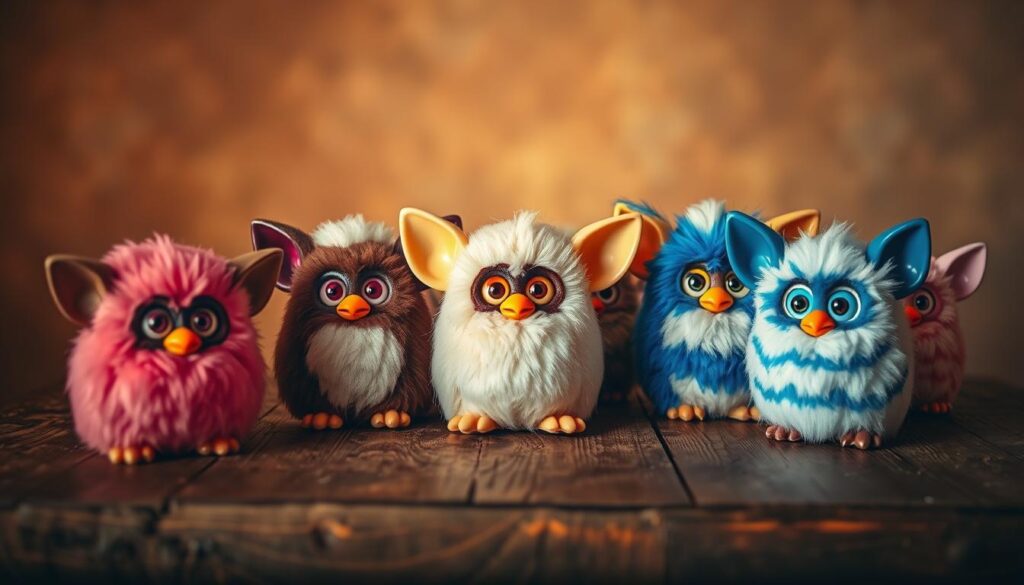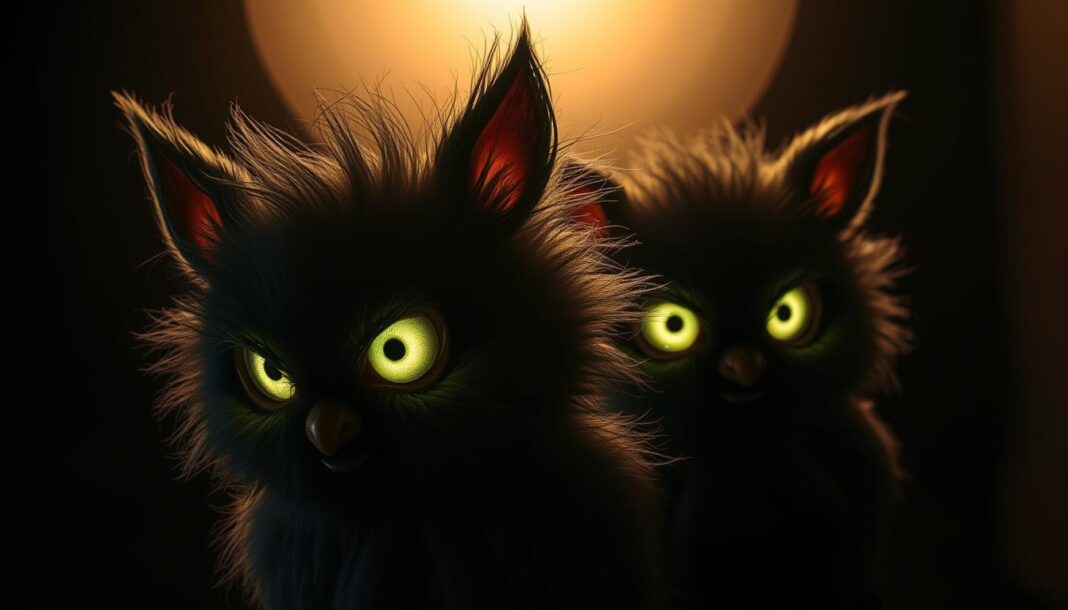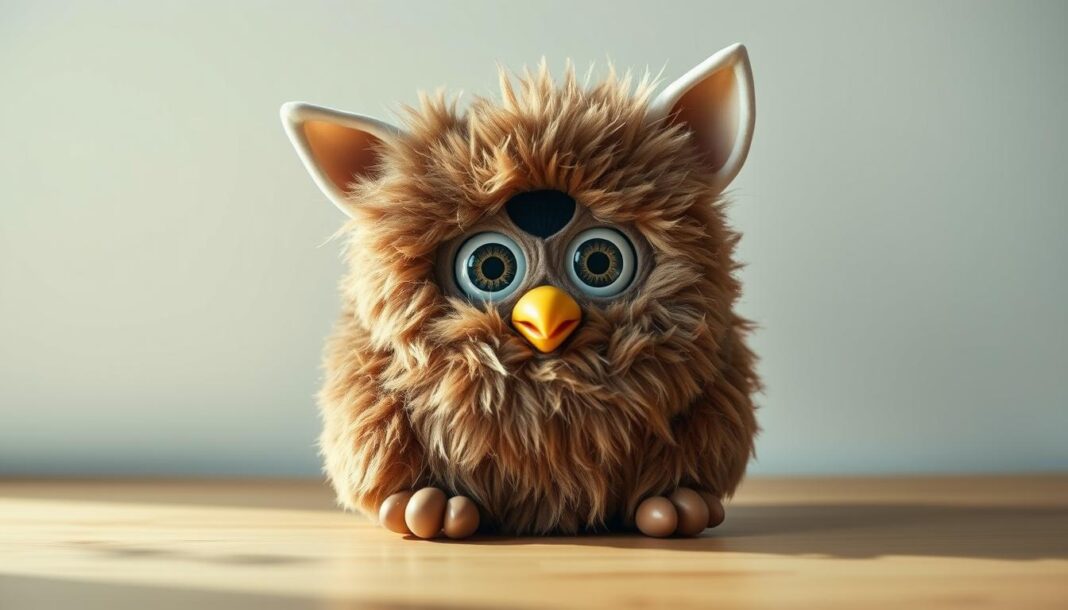In the late 1990s, a peculiar toy captured the hearts of children and adults worldwide, becoming a cultural phenomenon that still evokes nostalgia today. We’re taking a journey back to 1998 when the electronic companion first emerged, revolutionizing the toy industry with its interactive capabilities.
Released by Tiger Electronics, this toy was unlike anything seen before. It could “learn” English and respond to its environment, captivating the world with its futuristic appeal. As we explore in this article, the original electronic companion was not just a fleeting trend but a significant cultural touchstone of its time.
Over 40 million units were sold during its initial production run, with prices skyrocketing to hundreds of dollars above retail during peak holiday seasons. As we reminisce about the past, we’ll examine what made this toy so special and why it remains a cherished memory for many who grew up during that time.
The Birth of a Cultural Phenomenon
The Furby phenomenon began with a fascinating story of innovation and perseverance. The journey to creating this iconic toy involved several talented individuals and a significant amount of time and effort.
From Concept to Creation: The Inventors Behind Furby
Dave Hampton and Caleb Chung spent a total of 18 months designing and creating the original Furby. Their collaboration was instrumental in overcoming the numerous technical challenges they faced. After two initial attempts at licensing the concept, they were joined by fellow toy inventor Richard C. Levy, who played a crucial role in bringing Furby to Tiger Electronics. Roger Shiffman, a key figure at Tiger Electronics, recognized the potential of Furby and acquired the rights to it.
The 1998 Launch and Immediate Success
Furby’s first public appearance was at the American International Toy Fair in 1998, where it garnered significant attention from industry insiders. The toy was released in October 1998 and quickly became a sensation, with 1.8 million units selling almost immediately. The initial retail price was around $35, but the high demand during the 1998 Christmas period drove the resale price to over $100, and sometimes as high as several hundred dollars.
The success of Furby can be attributed to its innovative design and the strategic decisions made by its creators and marketers. Here’s a summary of the key events and figures involved in Furby’s launch:
| Event | Description | Year/Period |
|---|---|---|
| Design and Creation | Dave Hampton and Caleb Chung spent 18 months designing and creating Furby | Pre-1998 |
| First Public Appearance | Furby was showcased at the American International Toy Fair | 1998 |
| Release | Furby was released to the public, with 1.8 million units selling quickly | October 1998 |
| Price Surge | The resale price of Furby increased significantly due to high demand | 1998 Christmas Period |
Understanding the Original Furby
Delving into the world of the original Furby reveals a complex interplay of design elements and innovative technology. To truly understand this iconic toy, we need to examine both its physical appearance and the technology that brought it to life.
Physical Characteristics and Design Elements
The original Furby’sappearancewas one of its most striking features. With its owl-like shape, large expressive eyes, movable ears, and soft fur covering, it was instantly appealing to both children and collectors.The original Furbywas produced in variouscolorsand fur patterns by Tiger Electronics, creating a wide range ofmodelsthat encouraged collecting multiple Furbys. This diversity in design not only made each Furby unique but also contributed to the toy’s popularity.
The original Furby’s design was a key factor in its success as a toy. Its soft fur and movable parts made it cuddly and interactive, while its expressive eyes gave it a seemingly intelligent and responsive presence.
The Technology Inside: How Furbys Actually Worked
The technology behind the original Furby was groundbreaking for atoyat that time. The first Furby model was based around a 6502-style Sunplus SPC81A microcontroller, which had 80 KiB of ROM and 128 bytes of RAM. The Furby’s source code was written in assembly language for the 6502 microprocessor. A simple electric motor and a system of cams and gears allowed the Furby to blink, move its mouth, wiggle its ears, and even appear to dance, creating the illusion of complex movement.
| Component | Function |
|---|---|
| 6502-style Sunplus SPC81A microcontroller | Primary processing unit with 80 KiB of ROM and 128 bytes of RAM |
| TSP50C04 chip from Texas Instruments | Implemented linear predictive coding codec for voice synthesis |
| Simple electric motor and system of cams and gears | Created movements such as blinking, moving mouth, and wiggling ears |
The combination of the Furby’s physical design and internal technology created a seemingly intelligent and responsive companion that captivated children worldwide. Thefurby originalwas a true innovation in the world oftoys, leveraging advanced technology to create an interactive experience.
Furby’s Unique Features and Functionality
The original Furby was more than just a toy; it was an interactive companion that could speak its own language and learn from its environment. This section delves into the fascinating features that made Furby a standout in the world of electronic pets.
The Furbish Language and Learning Process
When first activated, Furbies spoke entirely in “Furbish,” a language consisting of 42 different words that formed hundreds of phrases with short syllables and distinctive sounds. As they “grew,” they gradually learned to speak more English (or one of eight other languages, depending on the variant). This learning process created an illusion of development and growth, captivating users. Furbies were programmed to speak less Furbish and more English over time, making it seem like they were learning and adapting.
For instance, Furbies could be taught to say certain pre-programmed phrases more often by petting them whenever they uttered these words. This feature led to a common misconception that Furbies could record and repeat words they heard, a myth that likely contributed to their ban from government agencies around the world due to security concerns.
Interactive Capabilities and Sensors
The original Furby was equipped with advanced sensors that allowed it to respond to light, sound, and touch. These interactive capabilities made Furby seem like a living creature, as it would react differently based on how it was treated and interacted with. One of its most impressive features was the ability to communicate with other Furbies via an infrared port located between their eyes, allowing them to “talk” and interact when placed face-to-face.
These features combined to create a toy that seemed to have its own personality and voice, responding differently based on user interaction. For those interested in exploring more about Furby’s evolution and impact, you can read about the Furby Boom and its continued popularity.
In summary, Furby’s unique blend of language, learning capabilities, and interactive sensors made it a revolutionary toy that captured the hearts of many. Its ability to simulate growth and interaction set a new standard for electronic pets and left a lasting impact on the toy industry.
The Furby Original Craze and Cultural Impact
During the 1998 holiday season, the demand for Furby far exceeded its supply, creating a nationwide shortage. This scarcity led to a surge in prices on the resale market, with desperate parents paying hundreds of dollars above the retail price to secure a Furby in time for Christmas.

Holiday Season Shortages and Resale Market
The high demand and limited supply of Furby led to the emergence of a secondary market where sellers could make significant profits by reselling these highly sought-after toys. Some Furbys were marked up to three or four times their original price, with buyers willing to pay top dollars to get their hands on one. This phenomenon highlighted the toy’s immense popularity and the challenges of meeting consumer demand during the peak holiday season.
As the shortage continued, it became clear that Furby had become more than just a toy – it was a cultural phenomenon. The toy’s scarcity and the resulting resale market frenzy cemented its place in the history of popular culture, with many regarding it as a must-have item of the late 1990s.
Security Concerns and Misconceptions
In January 1999, the National Security Agency (NSA) of the United States banned Furbies from entering NSA property due to concerns that they might be used to record and repeat classified information. The NSA believed that Furbies had an artificial intelligence chip that could “learn” from things users said around them. However, Roger Shiffman, the owner of Tiger Electronics, clarified that “Furby has absolutely no ability to do any recording whatsoever,” demonstrating how the toy’s apparent intelligence created genuine confusion.
The security concerns and subsequent media coverage only added to Furby’s mystique and popularity, solidifying its place in pop culture history. For more insights into the Furby experience, you can visit The Long Furby Experience, which provides a deeper dive into what made Furby so special during its time.
Special Editions and Variations of the Original Furby
Furby’s impact was further amplified by the release of several special edition models, catering to a wide range of consumers and collectors alike. These unique Furbys not only showcased the toy’s versatility but also contributed to its enduring popularity.
The release of limited edition Furbys was a significant aspect of the toy’s marketing strategy. These special Furbys were often tied to specific events, holidays, or popular culture franchises, making them highly collectible.
Limited Edition and Promotional Furbys
Limited edition Furbys were created for specific occasions, featuring unique colors and patterns that differentiated them from the standard models. Some of these editions were promotional, such as the Furby-style “Gizmo” from the film Gremlins, “Interactive Yoda” based on the Star Wars character, and “Interactive E.T.” from the movie of the same name. These special Furbys not only appealed to fans of the respective franchises but also to collectors looking to expand their Furby collections.
- Promotional models like “Gizmo,” “Interactive Yoda,” and “Interactive E.T.” were released as part of movie tie-ins.
- Unique colors and patterns made limited edition Furbys highly sought after by collectors.
- Special functionality in some editions further enhanced their collectibility.
International Versions and Language Adaptations
Furby’s global appeal was facilitated by the release of international versions and language adaptations. In Sweden, for instance, Swedish-speaking Furbys were marketed under the name “Furbee” to avoid confusion with a place of the same name. Moreover, Furbys were adapted to speak various languages, including French, Spanish, German, Italian, Japanese, Greek, and Portuguese, making them accessible to a broader audience worldwide.
The “Shelby” variant, released in 2001, was another notable addition to the Furby family. Resembling a clam, Shelby had improved memory and a distinct personality compared to the original Furby. It was also capable of communicating with original Furbys and Furby Babies, enhancing the interactive experience for users.
The diverse range of Furby models and editions not only reflected the toy’s popularity but also contributed to its collectibility. Fans and collectors sought out different variants to complete their collections, further fueling the Furby phenomenon.
Collecting Original Furbys in Today’s Market
The nostalgia surrounding Furbys has transformed them into highly sought-after collectibles. As we explore the current market, it becomes evident that the value of these iconic toys has appreciated significantly over the years.
For collectors, understanding the factors that influence a Furby’s value is crucial. We will delve into the key elements that determine the resale price of vintage Furbys, including their condition, rarity, and whether they are part of a limited edition.
Determining the Value of Vintage Furbys
When assessing the value of a vintage Furby, several factors come into play. The condition of the Furby is paramount; those that are in their original packaging or have minimal wear tend to fetch higher prices. Rarity is another significant factor, with special editions and unique color variants commanding premium prices. For instance, a rare “Kids Cuisine” Furby sold for $520, highlighting the importance of exclusivity in determining value.
To give you a better understanding, here are some key factors that influence a Furby’s resale value:
- Condition: Furbys in mint condition or with minimal wear are more valuable.
- Rarity: Limited edition Furbys or those with unique features are highly sought after.
- Original Packaging: Having the original packaging can significantly increase a Furby’s value.
- Special Colors: Unique or special color variants can command higher prices.

Preservation Tips for Furby Collectors
To maintain the value and condition of your Furby collection, proper preservation is essential. This includes storing them in a cool, dry place away from direct sunlight, cleaning them gently to avoid damage, and ensuring that batteries are maintained or removed to prevent corrosion.
For those looking to sell Furby collectibles, understanding the current market price is vital. Utilizing specialized online marketplaces and collector forums can help you reach potential buyers and achieve the best resale price.
By following these guidelines and staying informed about the market, collectors can enjoy their Furby collections while also making informed decisions about buying, selling, and preserving these beloved toys.
The Legacy of the Original Furby and Its Evolution
From its original release by Tiger Electronics to the latest versions, Furby has evolved remarkably, incorporating new features and technologies. The first Furby, released in 1998, was an instant hit, with 1.8 million units sold almost immediately. This initial success was just the beginning of Furby’s journey, as it continued to adapt and evolve over the years.
In 2005, a new Emoto-Tronic Furby was released, featuring improved voice recognition and more complex facial movements. This was followed by the 2012 revival when Hasbro announced a new line of Furbys with LCD eyes and adaptive personalities. The 2013 Furby Boom release introduced new colors, personalities, and a companion app that allowed children to hatch and raise virtual “Furblings” in a digital world.
The 2016 Furby Connect was the most technologically advanced variant, with color LCD eyes, Bluetooth connectivity, and an interactive app experience. The Furby Connect had an app called Furby Connect World, which contained a whole world of Furblings for it to interact with. Although the app was removed from mobile app stores in 2021, the Furby Connect remains a notable example of how Furby integrated mobile apps to extend the play experience.
As we examine the evolution of Furby, it’s clear that each new generation adapted to changing technology and play patterns. The original Furby’s legacy continues to influence interactive toys today, setting the standard for toys that seem to have personalities and can respond to their environment. For those interested in revisiting the original Furby experience, you can read more about it in our article on unboxing the original Furby.
The lasting place of Furby in our cultural memory is a testament to its impact and popularity. From its initial release to its continued presence in nostalgia-driven markets, Furby remains a beloved toy for many. Its ability to evolve and incorporate new technologies has ensured its relevance across generations.


